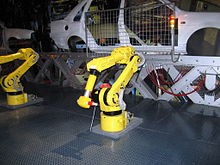
On October 26th and 27th 2018 Education and New Technologies together with engineers and scientists experienced in the field of mechatroniсs organized educational sessions at the Vocational School of Coding and Innovations for the students at the school and the children of Burgas.
What is Mechatronics?
Mechatronics is the point of contact between the various fields of the world of engineering. It brings together mechanical, electronic, computer, telecommunications, system and control engineering.
A mechatronic project is one that incorporates more than one sphere of engineering. For example, an assembly-line hand like that shown in the photo is a mechatronic project – it contains the software component (the programming of the microcontroller), the mechanical component (constructing the mechanical connections of the various “joints” of the hand) and the electronic component (the design of the circuit board that houses the microcontroller and the other electronic components). Yet another example are the robot-vacuum cleaners capable of going round a flat on their own and cleaning the floor – these also contain several abstractions and levels of engineering.
What is the objective of Mechatronics?
It is meant to train engineers in mechatronics who would be able to communicate in an engineering language with every single one of the engineers with narrow specialization who are part of the mechatronic projects (in other words to take the role of Team leaders), and to synthesize the whole information for the end client/ commissioner of the project/ company. The engineer in mechatronics lacks the knowledge and specialization of any one of the other engineers, but is just in marginal contact with their field.
What are the divisions and subdivisions of Mechatronics?
Mechatronics is the core, and the fields/jobs that it touches upon are briefly the following:
∙ Automotive – the people who are in the factories and the car production process
∙ Aerospace – the people producing objects to be launched into space
∙ Medical – the people producing and maintaining the medical equipment in hospitals
∙ Xerography – the people who produce and maintain the printers
∙ Defense Systems – all sorts of security systems
∙ Consumer Products – various devices, toys etc. that the modern consumer needs
∙ Manufacturing) – the people who assemble and adjust the products designed at a category of a higher level
∙ Materials Processing – the people who study the materials (metals, plastics etc.) to determine the most suitable material for a given product


